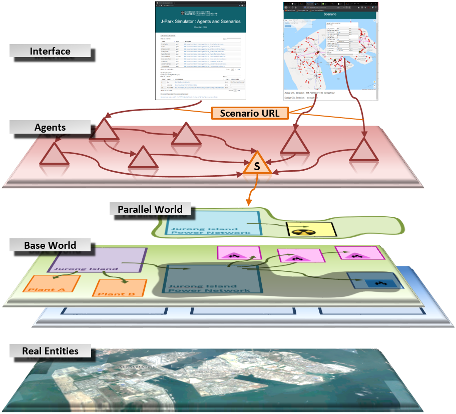Technical Report 249, c4e-Preprint Series, Cambridge
A Parallel World Framework for Scenario Analysis in Knowledge Graphs
Reference: Technical Report 249, c4e-Preprint Series, Cambridge, 2020
- Architecture of the J-Park Simulator and its Knowledge Graph
- Parallel World Framework based on Semantic Technologies
- Scenario-based Power Grid modelling and optimisation for carbon tax within the J-Park Simulator using the Parallel World Framework
 This paper presents Parallel World Framework as a solution for simulations of complex systems within a time varying knowledge graph and its application to the electric grid of Jurong Island in Singapore. The underlying modelling system is based on the Semantic Web Stack. Its linked data layer is described by means of ontologies, which span multiple domains. The framework is designed to allow for conducting multi-scale optimisations on complex superstructures within the system. Parallel World Containers, introduced by the framework, ensure data separation and versioning of structures crossing various domain boundaries. Separation of operations, belonging to a particular version of the world, is taken care of by a Scenario Agent. It encapsulates functionality of operations on data, and acts as a parallel world proxy to all of the other agents operating on the knowledge graph. Electric network optimisation for carbon tax is demonstrated as a use case. The framework allows to model and evaluate electrical networks corresponding to set carbon tax values by retrofitting different types of power generators and optimising the grid accordingly. The use case shows possibility of using this solution as a tool for CO2 reduction modelling and planning at scale due to its distributed architecture.
This paper presents Parallel World Framework as a solution for simulations of complex systems within a time varying knowledge graph and its application to the electric grid of Jurong Island in Singapore. The underlying modelling system is based on the Semantic Web Stack. Its linked data layer is described by means of ontologies, which span multiple domains. The framework is designed to allow for conducting multi-scale optimisations on complex superstructures within the system. Parallel World Containers, introduced by the framework, ensure data separation and versioning of structures crossing various domain boundaries. Separation of operations, belonging to a particular version of the world, is taken care of by a Scenario Agent. It encapsulates functionality of operations on data, and acts as a parallel world proxy to all of the other agents operating on the knowledge graph. Electric network optimisation for carbon tax is demonstrated as a use case. The framework allows to model and evaluate electrical networks corresponding to set carbon tax values by retrofitting different types of power generators and optimising the grid accordingly. The use case shows possibility of using this solution as a tool for CO2 reduction modelling and planning at scale due to its distributed architecture.
Material from this preprint has been published in Data-Centric Engineering.
PDF (2.3 MB)



